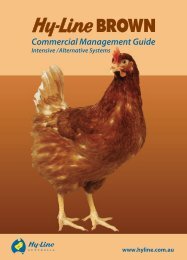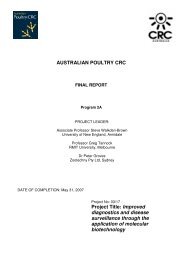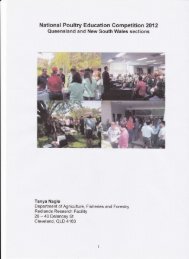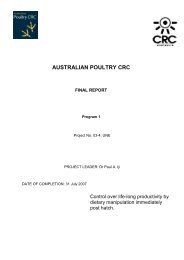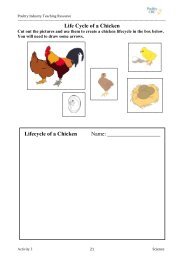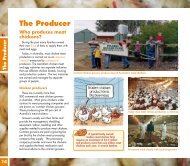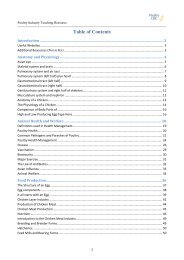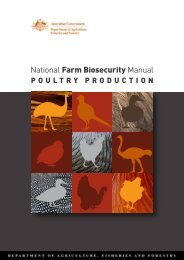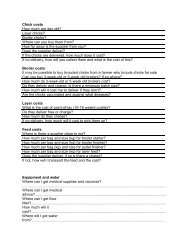AUSTRALIAN POULTRY CRC - Poultry Hub
AUSTRALIAN POULTRY CRC - Poultry Hub
AUSTRALIAN POULTRY CRC - Poultry Hub
- No tags were found...
You also want an ePaper? Increase the reach of your titles
YUMPU automatically turns print PDFs into web optimized ePapers that Google loves.
DiscussionRising EDS titres in a flock will indicate reinfection from wild birds which is important in relation topossible infection of flocks with avian influenza. Only one farm studied had a small increase in theaverage EDS titre with this farm and two others showing a decrease in the number of positive samplesover the period of the survey. Currently all pullets destined for commercial egg production in Australiaare vaccinated against IB with blood samples in this survey tested for circulating IB antibody titres asthere has been some suggestion that vaccines are not as effective as previously thought, and thepotential for a decline in immunity with time. Some farms did not show 100% positive samples forIBV titres at the start of the survey. The National Newcastle Disease Management Plan requires thatall states and territories of Australia make Newcastle disease vaccination compulsory. In Queensland,at least 66% of the birds sampled in a group must reach the target titre of 2 5 for birds over 18 weeks ofage. Overall, all flocks had a positive average NDV, IB and EDS vaccine titre throughout the survey;however farms 4 and 5 did not have a uniform distribution of the titres and therefore inadequateprotection for their flocks.Vaccination failures through incorrect vaccination methods and/or degradation of vaccine efficacy arepossible reasons for low titre results. Vaccines are dependent on conditions that will sustain their lifeor viability. Disinfectants, temperature and ultraviolet light can all alter or destroy the activecomponent of vaccines. It is critical that vaccines are transported and stored under correct temperatureconditions. If held in recommended conditions vaccines remain potent and effective until the expirydate. Stress may reduce a chicken‟s ability to mount an immune response and could includeenvironmental extremes, inadequate nutrition, parasitism and other diseases. Therefore vaccinationsshould be delayed during periods of stress (Butcher and Miles, 2003). Poor distribution of live vaccineadministered by water may result in chickens being „missed‟ in parts of the shed. This means relianceon bird to bird transmission of vaccine however if using a killed vaccine no transmission will occurand birds will have no protection. In a poultry operation the objective should be disease preventionthrough effective biosecurity however if a breakdown occurs, the vaccination program needs to beadequate and effective to limit resulting losses (Butcher and Miles, 2003).Reproduction tract lesions such as oophoritis, salpingitis, egg peritonitis, salpingoperitonitis, andimpacted oviduct were the most frequently encountered necropsy finding diagnosed in 185 dead birdsover a period of 3 months, presumably causing death of laying hens. Misshapen, discoloured cysticova, frequently containing caseous material in a thickened capsule were found in the abdominal cavityshowing extensive peritonitis with considerable fibrinous material or yolks. Enclosed yolks or caseousmaterial were also found in the oviduct. No changes in egg quality were reported. There areinnumerable factors that can initiate such pathologies however in most of cases they are associatedwith only a small number of mortalities caused by other complications such as acute and chronicperitonitis. Bacterial infection is a major contributory factor that should be taken into consideration ifthe frequency of these lesions increases in a flock. Various bacteria have been frequently reported tocause primary or secondary reproductive tract infections. It is also recognised that bacterial infectionseffect birds on the ground more than birds in cages. Although the route of infection is not clearlyknown, contamination of vent and cloaca/oviduct with faecal material has been seen as a source ofsuch lesions.To better understand the cause of the ovary and oviduct pathologies a follow-up investigation wascarried out to take sterile samples from fresh sacrificed morbid-looking birds (in total 61 birds weresacrificed from 3 farms during 3 months, see Appendix J) and conduct microbiological tests. It wasshown that 85% of birds did have similar reproductive tract problems as encountered in the pilot trial.From samples collected 33% did not show growth of bacteria; gram positive cocci (Staphylococcusspp.) were found present in 49% of all isolates; 18% of samples were gram negative cocci or rods. Thefrequency with which probable S. aureus/S. hyicus was isolated (15 from 30 isolates) suggests anaetiological relationship with encountered lesions. Additional factors such as immunosuppresioncaused by stress and the implications from other bacterial and parasitic infections in free range flocksmay have predisposed birds to opportunistic infections. Spotty liver and Coryza outbreaks werereported by producers in 3 free range flocks. In some cases parasite eggs, such as A. galli eggs, may28



